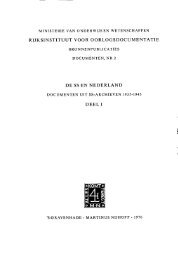De razzia van Rotterdam. 10-11 november 1944 - KNAW
De razzia van Rotterdam. 10-11 november 1944 - KNAW
De razzia van Rotterdam. 10-11 november 1944 - KNAW
Create successful ePaper yourself
Turn your PDF publications into a flip-book with our unique Google optimized e-Paper software.
2 6 8 SUMMARY<br />
destruction of the harbour works. Reference has already been made to the fact that<br />
on September 17, <strong>1944</strong>, a general railway strike broke out in the Netherlands which<br />
was virtually total in the <strong>Rotterdam</strong> area.<br />
The German Oberkommando der Wehrmacht (Armed Forces High Command)<br />
believed it had reason to fear the Netherlands resistance movement. The decision<br />
was taken to remove 600.000 able-bodied men from the Coastal areas of Western<br />
Holland.<br />
These men might be used in the German war economy. From the beginning of the<br />
occupation the Germans had used various methods to make Dutch manpower<br />
available to the German war economy. The <strong>razzia</strong>s of the famine winter were destined<br />
to be both the last and the most direct of the methods used.<br />
EXECUTION OF THE RAZZIA<br />
The military and other measures taken by the Germans in preparing the <strong>razzia</strong><br />
remained unknown to the population of <strong>Rotterdam</strong>. One of the <strong>Rotterdam</strong> underground<br />
papers had published several warnings that <strong>razzia</strong>s had been held elsewhere<br />
in the Netherlands. Nobody however, suspected that the Germans would strike such<br />
a heavy blow. A few weeks before November <strong>10</strong>, <strong>1944</strong> a German working in the<br />
principal strongpoint of the German military commander of <strong>Rotterdam</strong> had sent<br />
warning to a certain resistance organisation. As his reports were extremely vague<br />
and as the leaders of the resistance movement were loth to alarm the people without<br />
sufficiënt reason, the warnings were not passed on. It was not until the afternoon of<br />
Thursday November 9, <strong>1944</strong>, that this particular resistance organisation received<br />
information that it seemed probable that a large-scale <strong>razzia</strong> would be held on Friday,<br />
November <strong>10</strong>. There was no time to make this report generally known. It was, however,<br />
possible to send a warning to several members of the resistance movement and<br />
also a wireless message to the Dutch authorities in London asking them to urge the<br />
Allied Air Forces not to bomb or to machine gun large groups of men who might<br />
be leaving <strong>Rotterdam</strong> in the following days. As a result with one unimportant ex-<br />
ception the thousands of men who were marched out of <strong>Rotterdam</strong> were neither<br />
bombed or machine-gunned.<br />
After the German troops which were to be used in carrying out the <strong>razzia</strong>, about<br />
8.000 in all, had surrounded the town, all telephonic Communications were cut.<br />
This meant that the people of <strong>Rotterdam</strong> were unable to warn each other by<br />
telephone. The German troops started to enter the town at 0.00 hours on November<br />
<strong>10</strong>. They were heavily armed.<br />
All important squares and bridges were occupied. Their movements were not seen<br />
by the population, as a result of the curfew between 8 o’clock in the evening and<br />
4 o’clock in the morning. Some people remarked on the heavy military traffic. This,<br />
however, was no unusual occurrence and besides it was believed in the days preceding<br />
the <strong>razzia</strong>s that the Allied forces would start an attack in the area south of <strong>Rotterdam</strong>.






